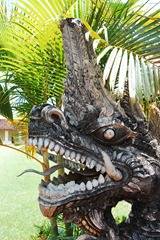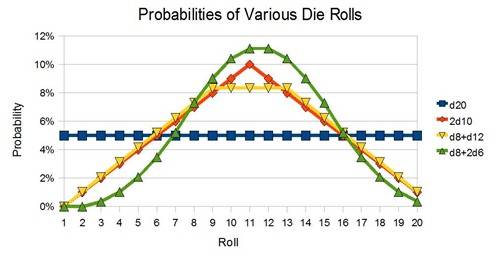 If you’re like me you’ve found yourself thinking the following: “I need to make an encounter table for this area. It’s a swamp, so I’ll just go though all my monster books and make a list of all the monsters that can live in swamps…” and then three pages of paper and way too much time later you succumb to information overload, shelf it and go do something else. A simple template can help reduce option paralysis and provides structure for an encounter list. Guidelines can also ensure enough diversity without over-planning too many encounters.
If you’re like me you’ve found yourself thinking the following: “I need to make an encounter table for this area. It’s a swamp, so I’ll just go though all my monster books and make a list of all the monsters that can live in swamps…” and then three pages of paper and way too much time later you succumb to information overload, shelf it and go do something else. A simple template can help reduce option paralysis and provides structure for an encounter list. Guidelines can also ensure enough diversity without over-planning too many encounters.
Characteristics:
It’s easiest to choose encounters by keeping in mind a few characteristics of the area in which the encounters will occur. Each of the following aspects can help choose both the frequency of different categories of encounter and the particular encounters that fit into that category. These characteristics only need to be classified as Low Medium or High and no more than a few seconds needs to be devoted to choosing each one. If you’re unsure if you should use Medium or High for a particular characteristic, just flip a coin and move on.
Life Level:
How alive is the area? How much diversity of plant and animal life is there? How much is there overall? Verdant forests, fertile grasslands, and vegetation-choked swamps all have high life levels while scorching deserts, rocky badlands and frigid tundras all have low life levels. The higher an areas life levels, the more slots should be in your final encounter table, and the more entries of each type.
Hazard Level:
How dangerous is it to live in this area? Do things live brutal short lives? Do you want lots of dangerous creatures? Is the area itself deadly? Different from life level which measures how many things and types of things live in an area, hazard level measures how often the things that do live there die. Deadly mires, inhospitable crags, and plague pits all have high hazard levels. Elven glades and carefully tended farmlands have low hazard levels.
Difficult Terrain Density:
How easy is it to move around the area? How maneuverable do you have to be to chase or evade prey? Can you take an afternoon jog without breaking your ankle or falling to your death? Jagged rockpiles, sinking bogs and dense forests all have high difficult terrain densities, while rolling grasslands, ancient roadways and sunbaked dirt flats all have low terrain densities.
Resource Level:
What’s here that anyone wants? Are there mineral deposits? Can the land be farmed, timber or wildlife harvested? Is the area tactically or economically valuable? Rocky terrain with rich ore veins, coastal land, and defensible high points have high resource levels. trackless wastes, rocky scrublands, and intraversable mud pits have low resource levels.
Ecological niches:
With these characteristics in mind there are six ecological niches in which encounters can fall. In general one to four encounters from each niche will create a complete list though this can be tweaked to work with particular games, campaigns, and areas. In general the higher an area’s life level and the lower it’s difficult terrain level, the larger the group it’s inhabitants should form.
Herbivores:
In this context, we’re defining herbivores as “Creatures that eat the environment” so while traditional herbivores fall in this category, wildly different environments like mine shafts, abandoned building, alternate planes and the like will have different sets of “Herbivores”. For the most part, we’re only interested in big nasty herbivores that regardless of whether they want to eat you or not will kick your ass for looking at them funny,large groups of herbivores that will trample you when spooked, or otherwise dangerous creatures. Rabbits are simply not an encounter unless they’re vorpal (and they’re still not herbivores).
Predators:
Usually predators are the most dangerous creatures in an area because they have to be able to kill and eat the rest of the population to survive. Again, depending on the mix of other creatures, what qualifies as a predator can be unusual. In a primal forest populated by plant creatures, that moose may well be your alpha predator.
Scavenger:
Creatures that eat other dead creatures but aren’t above an occasional fresh meal, there are a huge variety of scavengers but they’re usually underrepresented in gaming resources especially for odd environments. In a pinch lower level predators can fill the role of scavengers. The higher an area’s hazard levels the more scavengers can be found there.
Hazards:
Hidden deadly creatures such as vipers are hazards. Adapted to live is a high competition environment by being super lethal, but not super durable, they can often be handled as traps or skill checks. Unlike other encounter types, these are usually found singly and are most often found in areas with high hazard levels. Though most items on the list are creatures, hazards can be inanimate objects such as quicksand, pits etc…
Humanoids:
Able to live anywhere, there’s usually at least one group of humanoids living in or near any given area. Places will be hotly contested, and thus be home to more humanoids if they have high resource levels.
Elementals:
Some creatures have no ecological niche but live in areas simply because they are part of them.While this includes elementals, it might also include golems, fey, robots, or other weird creatures that are tied to a certain area and fall in no other category.
Putting it together:
Now you should have a list of creatures appropriate to your area that fill a variety of roles. All that’s left is to put them on a table. Chances are there are one or two too few or too many to fit a convenient number, so just ditch a few or grab a couple of your second string choices, toss them on a table and you’re good to go.
A brief note on die choice: With a single die, all outcomes are equally likely. The more dice you use, the greater central tendency of your roll, and the rarer the high and low values. Using dice of unequal size on the same roll will create a small “plateau” of probabilities in the center. It’s in no way essential to sit and crunch numbers, but keep in mind that if you use 5d6 for your table, the probability of rolling a 5 or a 30 is .01% so don’t expect to ever see it.
Example:
Here is an example using Fenwood from my Location Template Article:
Name: Fenwood
Life: High
Hazard: High
Difficult Terrain: High
Resource: LowHerbivores: catoblepas, giant beaver, elk
Predators: vampire, crocodile, cougars
Scavengers: giant beetle, mold men, dire crow
Hazards: viper, ant swarm, quicksand
Humanoids: swamp gnomes
Elementals: dark fey, living plants2d8
2 — vampire
3 — catoblepas
4 — giant beaver
5 — crocodile
6 — giant beetle
7 — ant swarm
8 — swamp gnomes
9 — quicksand
10 — elk
11 — cougar
12 — mold men
13 — dire crow
14 — viper
15 — living plants
16 — dark fey


















Excellent article, thank you Matthew!
I’m going to play around with this as soon as I get to my books, just for the fun of creating some tables. 😀
In fact, now that I think about it, creating a table this way could be a good inspirational springboard (is that the correct English term?) for designing a story. If you’re stuck for ideas, it’s always good to start doing *something*. Before you know it, inspiration hits and the ball is rolling. And this step-by-step method seems really perfect for it.
I totally identify with your lead-in about browsing for every monster that has to do with swamps. The template will prevent that and help you fill the creature roles only as full as you need them. What I need to really make it a snap though, is a way to map the encounters to the distribution. Is it like
2-4: elemental
5-6: herbivore
7-8: humanoid
9-11: predator
12-13: hazard
14-16: scavenger
? Or would you rank the individual creatures in order of how much you want to see them, and then give the highest creature the middle number of the distribution?
@Sektor – This is definitely a good springboard for ideas. More so, in my opinion than pouring through books, specifically because of information overload.
@Noumenon – That’s why I made a note about the probabilities involved. I definitely think you should mentally rank the entries from least to most common and make sure the ones you want to come up less are on the lower probability rolls. If you simply use a single die, you can instead assign more than one roll to entries you want to be more common.
This is a great template. It creates a sense of realism while staying simple. There’s even a category for me in there. 🙂
Very interesting article, Mathew, and one I shall be using as the start of a much more in-depth line of study along similar lines. Thank you for writing it.
One thing: “Living Plants?” Were you in my house this would need to be a much more unlikely category, but in a boggy wood? Last time I was in one I was tripping over the things.
BoD
This article hit a lot of sweet spots for me. (I *finally* registered so I could comment on this! Took me long enough…)
First, the breakdown of environmental and ecological categories is a great way to focus your mind on how to develop appropriate and cool encounters for any given location. But I also appreciate the reminder that multiple dice will create a bell curve for random statistics, whether they be encounters, NPC personality traits, or something else altogether.
Good stuff worth signing up for!
Regarding Roxysteve’s experience, it sounds like you need to move “Living Plants” towards the middle of that bell curve; he seemed to have a lot of trouble with them.
And to State the Obvious: Whenever you have two different poly-dice you can figure the plateau range by using the min value on each die and adding the max from the other. I often allow my D20 S&S players to use a system I call Steve Heroic to gen stats: D4+D6+8. The average roll is between 13 and 15 and no-one has a characteristic mod lower than zero when they are done. This is great for Convention Game pre-gens. Everyone is a heroic character in whatever context they like to play.